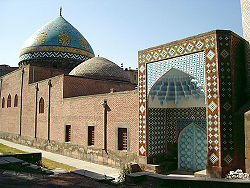
The following is a list of mosques found within the territory of modern Armenia.

The following is a list of mosques found within the territory of modern Armenia.

According to the 1870 publication of the Caucasian Calendar, a statistical report published by the Russian Viceroyalty of the Caucasus, there were a total of 269 Shia mosques in Erivan Governorate, a territory which today which comprises most of central Armenia, the Iğdır Province of Turkey, and the Nakhichevan exclave of Azerbaijan. [1]
According to Brockhaus and Efron Encyclopedic Dictionary , by the turn of the twentieth century, the population of Erivan (modern Yerevan), center of the Erivan Governorate, was over 29,000; of this number 49% were "Aderbeydzhani Tatars" (modern Azerbaijanis), 48% were Armenians and 2% were Russians, and there were seven Shia mosques in Erivan. [2] According to the traveler H. F. B. Lynch, the city of Erivan was about 50% Armenian and 50% Muslim in the early 1890s. [3] H. F. B. Lynch thought that some among the Muslims were Persians when he visited the city within the same decade. [4] According to modern historians George Bournoutian and Robert H. Hewsen, however, Lynch thought many were Persian. [5]

After the capture of Yerevan by Russians as a result of the Russo-Persian War, the main mosque in the city fortress, built by Turks in 1582, was converted to an Orthodox church under the orders of the Russian commander, General Ivan Paskevich. The church was sanctified on December 6, 1827, and named the Church of the Intercession of the Holy Mother of God. [6]
According to Ivan Chopin, there were eight mosques in Yerevan in the middle of the nineteenth century:
After 1917, many of the city's religious buildings were demolished in accordance with the Soviet government's modernization and anti-religious policies. The campaign included the demolition of churches, mosques, and the Sheikh Mordechai Synagogue in the city, the city's only synagogue. [9] According to the journalists Robert Cullen and Thomas de Waal, a few residents of Vardanants Street recall a small mosque being demolished in 1990. [10] [11] In 1988–1994 the overwhelming majority of the Muslim population, consisting of Azeris and Muslim Kurds,[ citation needed ] fled the country as a result of the First Nagorno-Karabakh War and the ongoing conflict between Armenia and Azerbaijan.